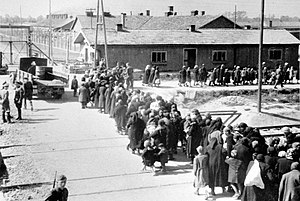Auschwitz Album
| The Auschwitz Album | |
|---|---|
Holocaust trains. Photo from the Auschwitz Album (May 1944) | |
 Jews from the Tét Ghetto walking toward the gas chambers located near crematoria II and III, 27 May 1944. Photograph from the Auschwitz Album |
The Auschwitz Album is a
Originally titled "Resettlement of the Jews from Hungary" (Umsiedlung der Juden aus Ungarn), it shows a period when the Nazis accelerated their deportation of Hungarian Jews to Auschwitz.[2] The images were taken by photographers from the camp's Erkennungsdienst ("identification service"). Among other things, the Erkennungsdienst was responsible for fingerprinting and taking photo IDs of prisoners who had not been selected for extermination.[3] The identity of the photographers is uncertain, but it is thought to have been Bernhard Walter or Ernst Hoffmann, two SS men who were director and deputy director of the Erkennungsdienst.[4] The camp's director, Rudolf Höss, also may have taken several of the photographs himself.[2]
The album has 56 pages and 193 photographs. Originally, it had more photographs, but before being donated to
Description
The images follow the processing of newly arrived
Purpose and intended audience
The album was likely produced to show the efficient operations of Auschwitz to an audience of high-level Nazi officials. The goal can be inferred from the album's contents, which focus on the processing of Hungarian Jews upon their arrival at the camp. The photographs were taken at a time when Eichmann accelerated the deportation of Hungarian Jews, with 650,000 people to be transported to Auschwitz in the course of three months. Rudolf Höss had been deployed to Auschwitz in May 1944 to oversee the operation, and the album highlights his management of the arrival process. The album has therefore been interpreted by scholars as an example of "internal propaganda" meant to show the orderly operation of the "Final Solution".[2]
History
The album's survival is remarkable, given the strenuous efforts made by the Nazis to keep the "Final Solution" a secret. Also remarkable is the story of its discovery.
The album's existence had been known publicly since at least the 1960s, when it was used as evidence at the
See also
- Höcker Album a collection of photographs with SS who ran the Auschwitz-Birkenau concentration camp
- Sonderkommando photographs taken at Auschwitz in 1944; possibly by Alberto Errera
- Wilhelm Brasse, prisoner and photographer at Auschwitz
Notes
- ^ The Auschwitz Album at Yad Vashem Archived 2018-07-17 at the Wayback Machine with supplementary data and bibliography. The Holocaust Martyrs' and Heroes' Remembrance Authority.
- ^ .
- ^ a b Hellman, Meier & Klarsfeld 1981, pp. xxiv–xxv.
- ^ Wontor-Cichy, Teresa (2012). "Erkennungsdienst—The Identification Service at Auschwitz". Wilhelm Brasse, Number 3444: Photographer, Auschwitz, 1940-1945. Krakow and Brighton: Sussex Academic Press. p. 14.
- ^ Hellman, Meier & Klarsfeld 1981, pp. viii–x.
- ^ "The mystery of the Auschwitz albums". History of Sorts. 2016-12-12. Retrieved 2023-04-12.
- ^ Hellman, Meier & Klarsfeld 1981, pp. ix–xx.
- ^ Hellman, Meier & Klarsfeld 1981, p. xxix.
Bibliography
- Hellman, Peter; Meier, Lili; ISBN 0-394-51932-9.
- Oliver Lustig's Text Presentation of Historic Holocaust Photographs from the Auschwitz Album from Holocaust Survivors and Remembrance Project: "Forget You Not"
